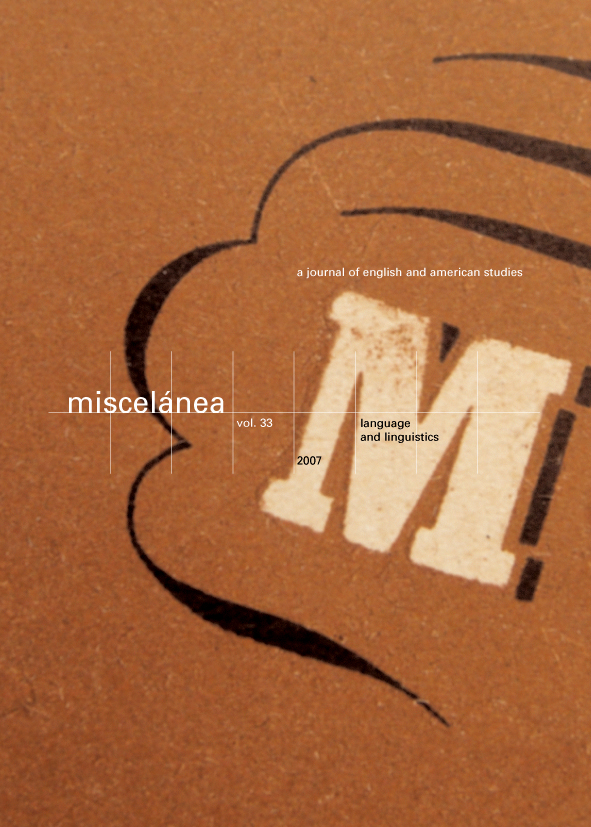Sexually Explicit Euphemism in Martin Amis's Yellow Dog. Mitigation or Offence?
DOI:
https://doi.org/10.26754/ojs_misc/mj.200610085Palabras clave:
eufemismo, eufemismo explícito, interdicción sexual, Martin Amis, Yellow DogResumen
El objetivo del presente artículo es ofrecer una perspectiva general de la modalidad eufemística que denomino ‘eufemismo explícito’ mediante el análisis del tabú sexual en la novela de Martin Amis Yellow Dog (2003). Mantengo que en el lenguaje literario actual el eufemismo no se ajusta al concepto tradicional del fenómeno. De hecho, alusiones explícitas a realidades sexuales desempeñan la principal finalidad eufemística en tanto sirven para evitar palabras y expresiones consideradas inadecuadas en la interacción social, en especial las voces malsonantes de naturaleza sexual (cunt, fuck, etc.). En este sentido, la novela de Amis constituye un ejemplo representativo del tratamiento que el ámbito sexual recibe en la actualidad, integrado en un discurso en el que suele ser difícil distinguir el eufemismo del disfemismo, la atenuación de la ofensa verbal. A fin de dar cuenta de la incidencia de esta modalidad eufemística en la narrativa actual, la última parte del artículo presenta un glosario con los casos de eufemismo explícito hallados en la novela apuntada.
Descargas
Referencias
Abrantes, Ana M. 2005. “Euphemism and Cooperation in Discourse”. In Grillo, Eric (ed.). Power Without Domination. Dialogism and the Empowering Property of Communication. Amsterdam, Philadelphia: John Benjamins: 85-103.
Allan, Keith and Kate Burridge. 1991. Euphemism and Dysphemism. Language Used as Shield and Weapon. New York, Oxford: Oxford U.P.
Amis, Martin. 1975. Dead Babies. Harmondsworth: Penguin.
—. 2003. Yellow Dog. London: Vintage.
Bultnick, Bert. 1998. Metaphors We Die By: Conceptualizations of Death in English and their Implications for the Theory of Metaphor. Antwerpen: Universiteit Antwerpen.
Burgen, Stephen. 1996. Your Mother’s Tongue. London: Indigo.
Burridge, Kate. 1996. “Political Correctness. Euphemisms with Attitude”. English Today 47, 12 (3) (July 1996): 42-43, 49.
—. (2002) 2004. Blooming English. Cambridge: Cambridge U.P.
Casas Gómez, Miguel. 1986. La interdicción lingüística. Mecanismos del eufemismo y disfemismo. Cádiz: Universidad.
Chamizo Domínguez, Pedro J. and Francisco Sánchez Benedito. 2000. Lo que nunca se aprendió en clase. Eufemismos y disfemismos en el lenguaje erótico inglés. Granada: Comares.
—. forthcoming. “Linguistic Interdiction: Forbidden Words and the Censoring of Language”. Language Sciences.
Crespo Fernández, Eliecer. 2005. El eufemismo, el disfemismo y los procesos mixtos. La manipulación del referente en el lenguaje literario inglés desde mediados del siglo XIX hasta la actualidad. Unpublished Ph.D Thesis. Alicante: Universidad.
—. 2005b. “Euphemistic Strategies in Politeness and Face Concerns”. Pragmalingüística, 13: 77-86.
—. 2006a. “Metaphor in the Euphemistic Manipulation of the Taboo of Sex”. Babel A.F.I.A.L. 13: 27-42.
—. 2006b. “El valor del eufemismo y disfemismo en la lengua literaria en inglés: una aproximación léxico-discursiva al fenómeno de la interdicción verbal”. Estudios de Filología Moderna, 5-6: 73-86.
—. 2006c. “Euphemism and Conceptual Metaphorization in Victorian Obituaries”. SKY Journal of Linguistics, 19: 101-133.
—. 2007. El eufemismo y el disfemismo. Procesos de manipulación del tabú en el lenguaje literario inglés. Alicante: Universidad.
Diedrick, James. 2003. “The Martin Amis Web”. On line at http://www.martinamis.albion.edu
Epstein, Joseph. 1985. “Sex and Euphemism”. In Enright, D.J. (ed.). Fair of Speech. The Uses of Euphemism. Oxford: Oxford U.P.: 56-71.
Ham, Kerry L. 2005. “The Linguistics of Euphemism: A Diachronic Study of Euphemism Formation”. Journal of Language and Linguistics, 4 (2): 227-263.
Lakoff, George. (1979) 1994. “The Contemporary Theory of Metaphor”. In Ortony, Andrew (ed.). Metaphor and Thought. Cambridge: Cambridge U.P.: 202-251.
—. and Mark Johnson. 1980. Metaphors We Live By. Chicago: Chicago U.P.
Leech, Geoffrey. 1974. Semantics. Harmondsworth: Penguin.
Marín Arrese, Juana I. 1996. “To Die, to Sleep. A Contrastive Study of Metaphors for Death and Dying in English and Spanish”. Language Sciences,18 (1-2): 37-52.
Montero Cartelle, Emilio. 1981. El eufemismo en Galicia (su comparación con otras áreas romances). Santiago de Compostela: Universidad.
O’Connor, Michael. 2003. “Yellow Dog by Martin Amis”. On line at http://www.contemporarylit.about.com.od.fiction/fr/YellowDog.htm
Shilling, Jane. 2003. “Fear and Loathing: As Usual”. On line at http://www.co.uk./arts.main.jhtmlxml=arts2003/08/31/boam231.xml
Sperber, Dan and Deirdre Wilson. (1986) 1995. Relevance. Communication and Cognition. Oxford: Basil Blackwell.
Ullmann, Stephen. 1962. Semantics. Oxford: Basil Blackwell.
Descargas
Publicado
Número
Sección
Licencia
Derechos de autor 2009 Eliecer Crespo Fernández

Esta obra está bajo una licencia internacional Creative Commons Atribución-NoComercial 4.0.


